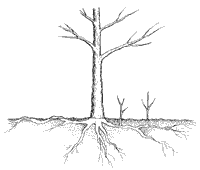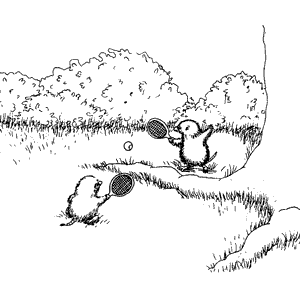Dealing With Tree Surface Roots
One of the problems with having large trees in your yard are the surface roots that sometimes develop along the surface of the lawn around a large tree. They get skinned by the lawn mower, buckle sidewalks, trip people walking in the yard, and look unsightly. What to do?
 |
Why Surface Roots?
Such roots typically appear when trees are about 10" in diameter or larger. If you don't want surface roots, then you should avoid trees that get big in a hurry, such as Poplars, certain Maples, and some Willows (see list below). Surface rooting is promoted by heavy, poorly drained, and/or shallow soils, which have low oxygen content--the roots need oxygen to grow, and so tend to form near the surface of the soil, then grow above the soil surface as they become larger. Surface roots also can become exposed by soil erosion.
You Can Prune The Roots
A radical solution is pruning, which might be appropriate if the roots are heaving or cracking paving. Cut the roots off cleanly, don't just cut off their aboveground parts (that would expose the whole tree to massive infection by decay organisms); but even the best possible job of pruning large roots can result in severe damage to the tree--even death. Never cut off more than half of a tree's functioning roots; one fourth or less is better. After pruning, "pamper" the tree by treating it as if it had just been transplanted. Be sure to give it lots of water.
 |
Try Covering The Roots
A less drastic way to solve the problem is to cover the surface roots with "light" soil (topsoil mixed with peat moss or sand, for instance). Don't cover the roots with much more than about 2 inches of soil, or the tree might die within a few years and you'll not be sure why it died.
Ground Covers Do The Job
If you don't want to remove or bury the roots, why not avoid mowoing around them? Plant a ground cover around the tree. Of course, ground covers are not suitable for high traffic areas. A course mulch such as wood ships or bark might substitute for living ground covers, but don't apply more than about 4 inches deep, and avoid placing the mulch cose to the trunk, where it could lead to animal damage (mice and voles).
Avoid The Problem First
The ultimate solution to surface root problems is to remove offending trees. If you do this, make sure that replacements are located at least four feet from paved areas, and pick trees that are slow to produce surface roots.
Trees often having large surface roots include Norway Maple, Silver Maple, American Beech, European Larch, Sweet Gum, Dawn Redwood, White Mulberry, Colorado Blue Spruce, Poplars, Pin Oak, White Willow, Bald Cypress and Lindens.
Slow growing trees usually not having surface roots include Japanese Maple, Red Buckeye Juneberry, Hornbeams, Dogwoods, Hawthorns, European Beech, Sourwood, and Bur Oaks.

